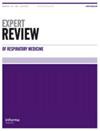Dupilumab诱导的嗜酸性粒细胞增多症:文献综述和临床治疗算法建议
IF 2.9
3区 医学
Q2 RESPIRATORY SYSTEM
引用次数: 23
摘要
摘要简介Dupilumab是一种靶向IL-4和IL-13信号传导的人单克隆抗体。目前,它适用于治疗哮喘、中重度特应性皮炎和慢性鼻窦炎伴鼻息肉(CRSwNP)。嗜酸性粒细胞增多症已被报道为治疗患者的潜在不良事件。涵盖领域截至2022年1月,在PubMed和Medline上进行了选择性搜索,重点关注临床试验、现实生活研究和病例报告中描述的杜匹单抗诱导的嗜酸性粒细胞增多症。dupilumab诱导的嗜酸性粒细胞增多和嗜酸性粒相关发病率的可能机制也已被探讨。专家意见处理杜匹单抗诱导的嗜酸性粒细胞增多症是临床医生管理杜匹单抗治疗患者的一项临床挑战。为了正确研究潜在的嗜酸性粒细胞相关发病率并避免不必要的停药,已经提出了一种实用的治疗杜匹单抗诱导的嗜酸性细胞增多症的算法。本文章由计算机程序翻译,如有差异,请以英文原文为准。
Dupilumab-induced hypereosinophilia: review of the literature and algorithm proposal for clinical management
ABSTRACT Introduction Dupilumab is a human monoclonal antibody that targets both IL-4 and IL-13 signaling. It is currently indicated for the treatment of asthma, moderate-to-severe atopic dermatitis, and chronic rhinosinusitis with nasal polyps (CRSwNP). Eosinophilia has been reported as a potential adverse event in treated patients. Areas covered A selective search on PubMed and Medline up to January 2022 was performed, by focusing on dupilumab-induced hypereosinophilia described in clinical trials, real-life studies, and case reports. The possible mechanisms underlying dupilumab-induced hypereosinophilia and the eosinophil-related morbidity have also been explored. Expert opinion Dealing with dupilumab-induced hypereosinophilia represents a clinical challenge for clinicians managing patients on dupilumab therapy. An algorithm for the practical management of dupilumab-induced hypereosinophilia has been proposed, in order to properly investigate potential eosinophil-related morbidity and avoid unnecessary drug discontinuation.
求助全文
通过发布文献求助,成功后即可免费获取论文全文。
去求助
来源期刊

Expert Review of Respiratory Medicine
RESPIRATORY SYSTEM-
CiteScore
6.80
自引率
2.60%
发文量
90
期刊介绍:
Coverage will include the following key areas:
- Prospects for new and emerging therapeutics
- Epidemiology of disease
- Preventive strategies
- All aspects of COPD, from patient self-management to systemic effects of the disease and comorbidities
- Improved diagnostic methods, including imaging techniques, biomarkers and physiological tests.
- Advances in the treatment of respiratory infections and drug resistance issues
- Occupational and environmental factors
- Progress in smoking intervention and cessation methods
- Disease and treatment issues for defined populations, such as children and the elderly
- Respiratory intensive and critical care
- Updates on the status and advances of specific disease areas, including asthma, HIV/AIDS-related disease, cystic fibrosis, COPD and sleep-disordered breathing morbidity
 求助内容:
求助内容: 应助结果提醒方式:
应助结果提醒方式:


